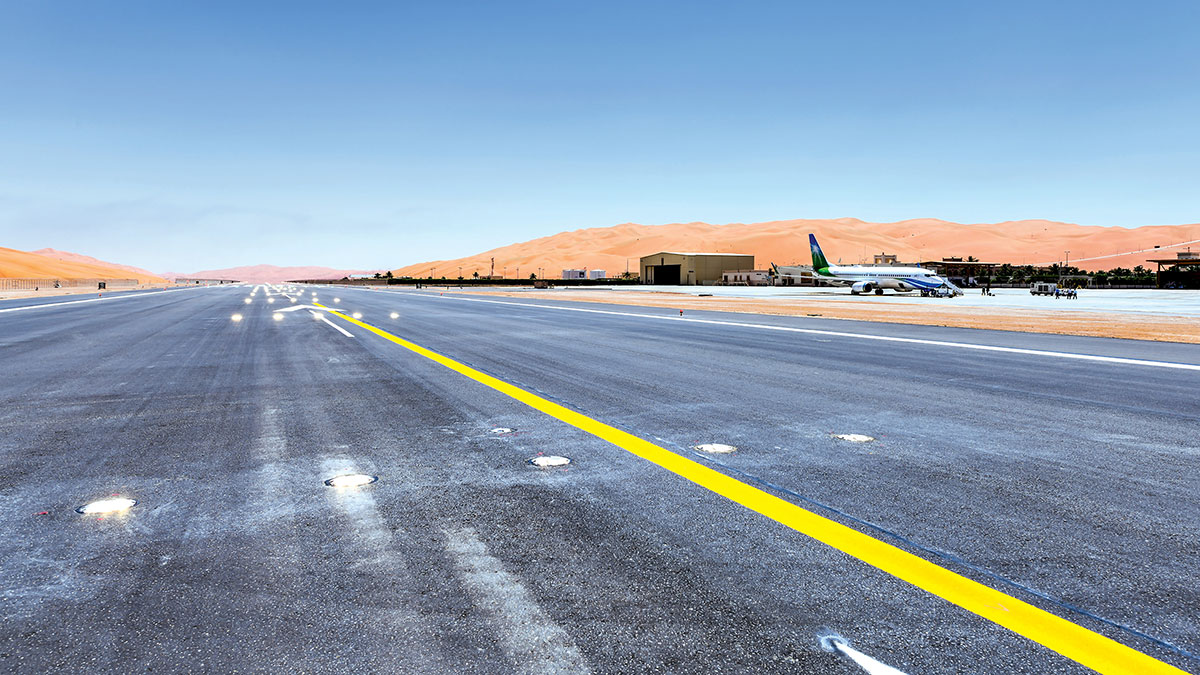Shaybah airstrip upgrade receives international excellence award

Global November 04, 2020 - By
On Oct. 20, Saudi Aramco’s Shaybah airstrip upgrade project received the 2020 Project Excellence Award for Europe, Middle East and Africa during a virtual meeting hosted by the Project Management Institute.
The company deployed innovative construction technologies and demonstrated high efficiency and effective leadership, completing the challenging project in 77 days — 4 months ahead of schedule — and with zero incidents.
This is an achievement that exceeded all expectations.
— Ahmed O. Aredhi, Oil Facilities Projects Department manager
“The early completion was driven by robust logistic planning, technology utilization, and remarkable collaborative effort from all stakeholders working tirelessly to deliver the project in the shortest time possible,” said Aredhi.
Led by Saudi Aramco’s Project Management team, the project demanded the expertise and dedication of several Aramco entities and professionals, including Aviation, Transportation and Equipment Services, Project Inspection, and Consulting Services departments.
The team was also fully supported by several additional departments and affiliates, including Aramco Overseas Company, Shaybah Producing, Materials and Logistics, Industrial Security, Facilities Planning, Project Management Office Department and of course, the company’s contractor, Sinohydro Corporation.
Upgrading runway and lighting
After two decades of service in the harsh and unyielding desert of the Rub’ al-Khali (The Empty Quarter), the 10,000 foot runway serving Shaybah oil field was in need of an upgrade to maintain the safety of aviation operations at the field.
The restoration project included resurfacing the battered runway using a cost saving and environmentally friendly method called “rubblization,” where the existing concrete is broken up and used as a base for asphalting — a first for Saudi Aramco.
“Instead of disposing of the concrete, we reused the existing material and increased the life expectancy of the runway to 30-40 years at a third of the cost,” said project engineer Helder Martins, noting that this was only the second application of rubblization in the Kingdom after the Jiddah International Airport.
This giant undertaking required a vast array of skill sets and took two and a half years of meticulous planning, including studies conducted by Aviation and the Facilities Planning Department with the support of King Fahd University of Petroleum and Minerals to reach the best possible solutions for the refurbishment.
“Shaybah is a difficult and harsh environment to work in and geographically very far from any nearby city,” said Aredhi. “To get manpower promptly or even the smallest tool would require an airline trip, so it’s not as easy as doing operations in a city like al-Khobar or Abqaiq.”
Indispensable transportation hub
The Shaybah airstrip was originally constructed in 1997 between two salt flats amid a sea of sand dunes rising up to 175 meters above the runway in the vastness of the Rub’ al-Khali desert. This runway plays a critical role in delivering millions of barrels of natural resources every day to customers as well as conveniently transporting employees and contractors to and from the enormous oil base.
“Early planning was key for this project because the airport is the main connection point for that area and its closure would impact the entire population of Shaybah,” said Nezar H. Khalifah, head of the Shaybah Crude Increment Projects Division. “The nearest city to Shaybah is al Hasa, a 600 km drive, which was not recommended as an alternative hub, due to the huge volumes of personnel and weekly transportation requirements.”
The initial plan was to keep the airport open and allow planes to land and take off on part of the runway, upgrading in two phases. However, the team identified through simulations several safety risks associated with keeping the airport open and a decision was made to shut it down and divert all traffic to the nearest government airstrip 150 km away. This created a new challenge as that strip could only be reached on a difficult 90-minute drive through a two-way road.
Instead of disposing the concrete, we reused the existing material and increased the life expectancy of the runway to 30-40 years at a third of the cost.
— Helder Martins
Safety above all
Despite the challenges and difficult landscape, 40,000 personnel commuted successfully and safely from and to Shaybah on fleets of buses that are estimated to have taken 1,800 trips in three months to complete the project.
“To increase the safety and security of the road between the airports, the Aviation and Transportation departments renovated some of the pavement and created shoulders for emergency stops,” said Martins. “We also brought a third-party traffic control to monitor the safety of the road for our vehicles.”
The team completed the project ahead of schedule.
“Even with the accelerated nature of this project with continuous labor and machinery working around the clock, the construction activities were completed safely, with zero incidents or near misses,” said Martins.
Top photo caption: The life expectancy of the refurbished runway in Shaybah is now 30 to 40 years.



